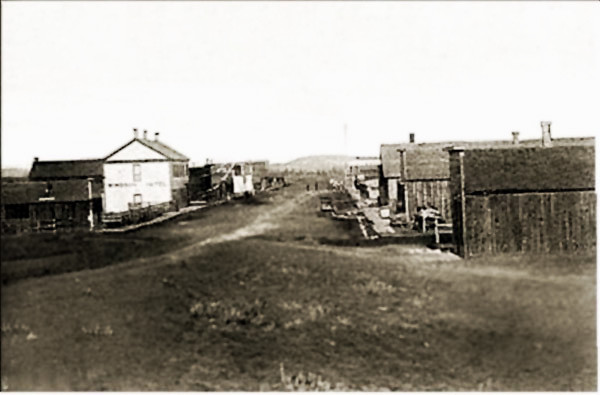
Main Street, looking North toward intersection of Main and Works, 1887
The two-story building in the photo to the
left is the Windsor Hotel operated by Benjamin F. A. Kueny (1842-1907). The hotel was torn down in 1896 and replaced by the
Hotel Towns, later renamed the Great Western Hotel.
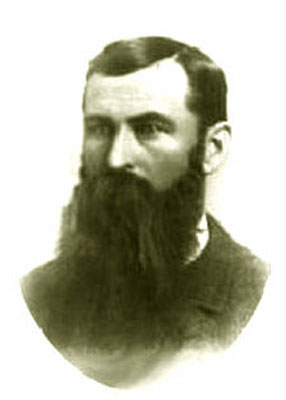 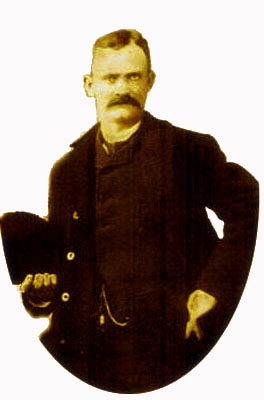
Left,
John D. Loucks, the founder of Sheridan.
O. P. Hanna.
With the opening of Northern Wyoming at the end of the Indian Wars, the area of
present day Sheridan was ripe for development. The first cabin in the area of Sheridan was
constructed in 1878 by Oliver Perry Hanna (1851-1934) at Big Horn to the southwest of
present day Sheridan. Because of his fondness for chewing tobacco, Hanna was known to the
Indians as "Heap "Spit." Hanna established a farm with Jno. Bennefiel on Goose Creek.
Only two years before Hanna constructed his cabin, the area of
the confluence of Big and Little Goose Creeks was the site of
Gen. George Crook's base camp in the so-called "Horse Meat Campaign." Hanna had been a
soldier with Gen. Crook's forces. The two creeks rise on the east side of the Big Horn Mountains to the west and south
of Sheridan and combine to form
Goose Creek which in turn flowsinto the Tongue River to the north of Sheridan near Kleenburn.
Sheridan was laid out in 1882
by John D. Loucks who arrived in the area from Miles City and purchased a
land claim and cabin from George Mandel for $500.00. The cabin had been erected by
Jim Mason in 1878. Mason sold the cabin to Frank Yates and John F. "Bean Belly"
Brown who, in turn sold the cabin to Mandel. The cabin is still in existence although it has
been moved. Loucks was originally going to settle in Big Horn, a small town to the south-west of present day
Sheridan. On the way to Big Horn, Loucks' horse gave out and he started to walk. He stopped to
rest on the hill where the courthouse is presently located and was inspired by the
view. Thus, in a sense, Sheridan owes its existence to a worn-out horse. Loucks drew a plat for his proposed town on the back of a sheet of wrapping paper.
Based on Loucks' drawing, professional surveyors laid out the town, the plat was approved, and
a post office established with Loucks as the first contract postmaster. Loucks' compensation on a commission
basis for the first three months was $13.45. The City was
incorporated two years later in 1884 with Loucks the first mayor. Loucks, a Civil War veteran, named the
City after his old commanding officer. By 1885 the Big Goose was being used as a source of
irrigation. See generally Big Goose and Beaver Ditch Company v. Wallop
, 382 P. 2d 388 (Wyo. 1963). With irrigation and a comparitively mild climate as a result of its lower
elevation, the Big Goose Valley became ideal for agriculture. In 1888, Sheridan County was formed from
Johnson County and the city was designated as the seat in a contest with Big Horn and
Dayton.
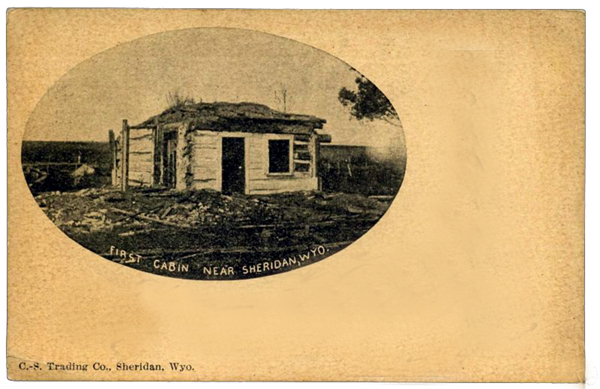
Oliver Perry Hanna Cabin, circa 1906.
With the arrival of the railroad in 1893 and its need for railroad ties, large scale timber operations began in the Big Horns west of
Sheridan. The tie treatment plant depicted in the next photo was opened by the railroad in
railroad in 1899.
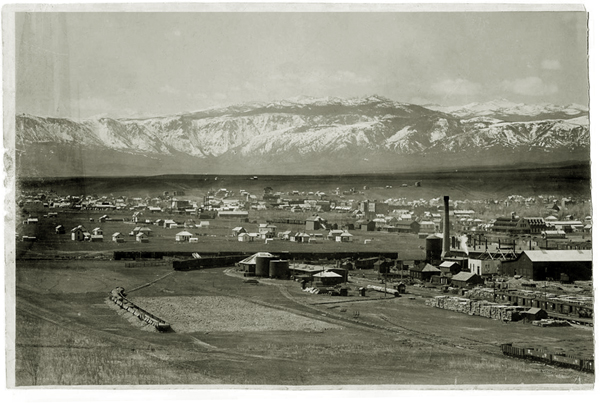
Sheridan looking southwest approx. 1900
In the foreground is the railroad tie yard. Toward the right beyond the tie treatment plant
is the Sheridan Inn constructed in 1893 by the
Chicago, Burlington & Quincy Railroad as a part of its development operation. Later for a short period of time before he moved to
Cody, the hotel was operated by
Col. Wm. F. "Buffalo Bill" Col. Cody's unsuccessful divorce action was moved to Sheridan from Big Horn County.
The divorce was denied.
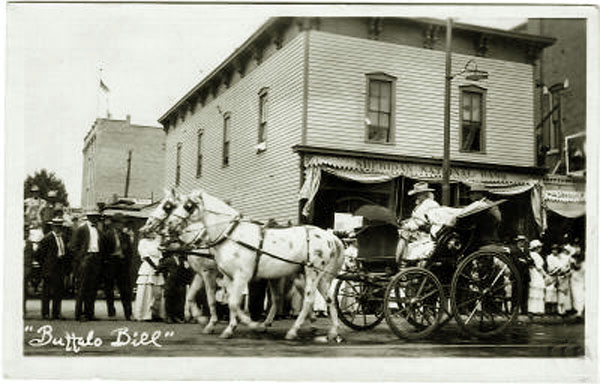
Col. Cody passing in front of the Sherican National Bank, August 9, 1914.
Subsequent to 1905, Cody visited the City twice, once in 1910 and again in August 1909 in conjunction with the Sells-Floto Circus which has absorbed the
remnants of Col. Cody's Wild West show. Shortly before Cody's visit to Sheridan in 1914, a former partner in the Wild West show, John Burke visited
Shridan and stopped into visit his old friend Sherman D. Canfield (1865-1939) who for a period of time had
managed the Sheridan Inn and served as financial director for the City of Sheridan. Burke did not stay around for
Col. Cody's arrival. Burke was known for his bon mots of wisdom such as:
You Can notch it on the railing
As a mighty risky plan,
To form your opinions
By the clothes that's on the Man,
For you can bet your bottom dollar
You often come across
A fifty dollar saddle
On a twenty dollar horse.
Writer's personal note: It kind of reminds me of someone I knew who was an auto mechanic. He refused
to service an expensive German car (used) on which the owner had put recapped tires.
The hotel is on the National Register. Several close-up views of the hotel
are depicted further below on this page.
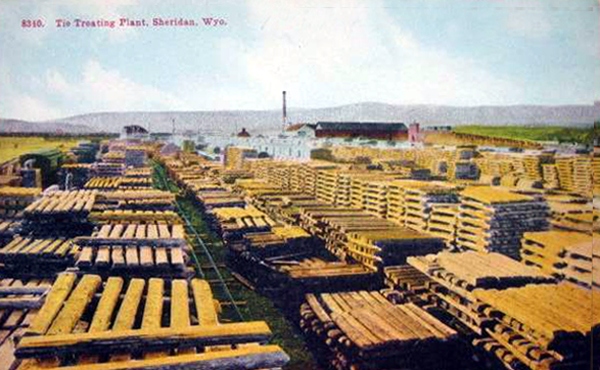
Sheridan Iie Treatment Plant, approx. 1913.
The last tie treatment plant in Wyoming was in
Riverton and closed in 1969.
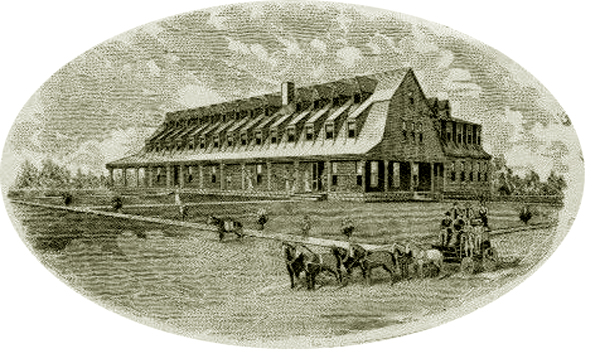
Sheridan Inn, approx. 1900.
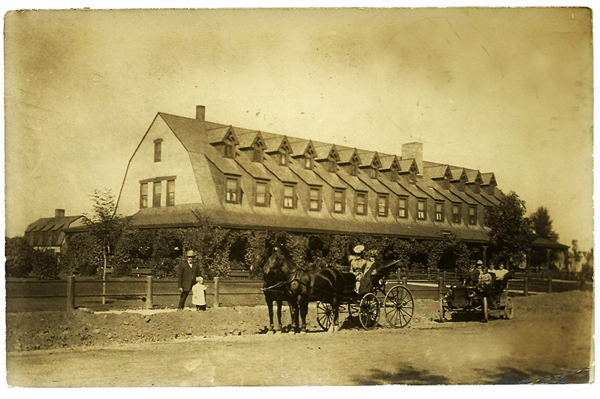
Sheridan Inn, 1907.
The Sheridan Inn was designed by noted Omaha architect Thomas R. Kimball ((1862-1934). Kimball who had attended the
L'Ecole des Beaux Arts and was appointed to commissions for numerous public buildings and two
major expositions including the Columbian Exposition of 1892. He served as president of the American Institute of Architects.
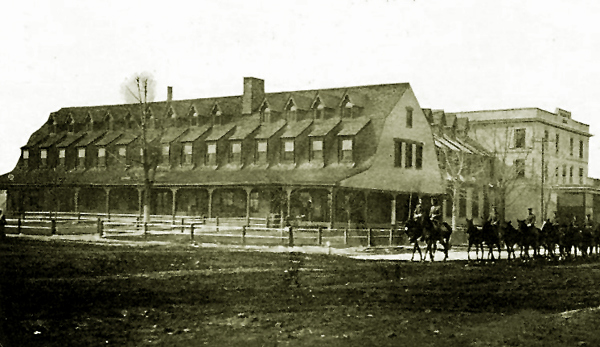
Unit of cavalry passing in front of the Sheridan Inn, undated.
Kimball spent time in the United Kingdom doing genealogical research on his ancestors.
Allegedly, the design of the hotel was inspired by a hunting lodge in which
Kimball had stayed while in Scotland.
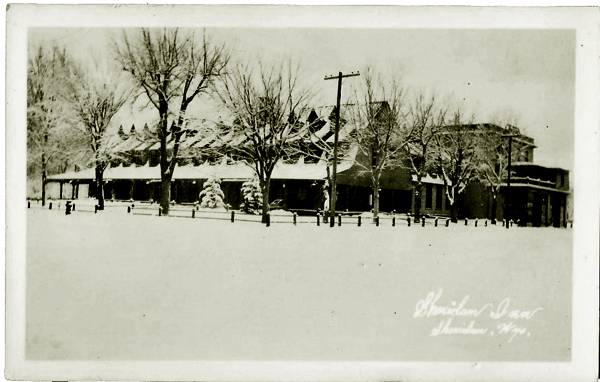
Sheridan Inn, 1937.
Some have claimed that within the Inn the spirit of "Kate Arnold (1879-1969) still makes bids visitors welcome.
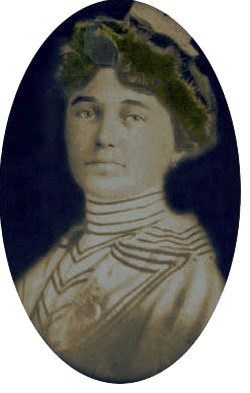 Kate B. Arnold Kate B. Arnold
Miss Kate worked at the hotel from 1901 until it closed in 1965. Following her death, her remains were cremated.
In reality she may still remain in the Inn. Allegedly her ashes were placed behind a wall in the
hotel and in various renovations since its reopening have never been found.
The Sheridan Inn was not the only contribution by Kimball to the Sheridan area. High in the Big Horns Kimball designed the Dome Lake
Club House. The Club was constructed after the railroad sent a scouting party led by
Edward Gillette into the Big Horns.
On the expedition they observed a chain of lakes. Access to The
territory around the Big Goose was well nigh impossible. C. P. Hubbard later explained:
Late in the autumn of that year he guided a party of friends around to where these lakes could be seen
and with infinite difficulty they worked their way through dense fallen
timber and young growth pine to the narrow mountain meadows skirting the
lakes. It was through this section that the Sioux InŽdians retreated after
the Custer Massacre on the Little Big Horn in 1876. setting fire to the
timber as they went to cover their retreat. In course of time storms blew
the dead trees in all direcŽtions like a bunch of jack straws and the young
growth, locally known as "jack pine," growing up through this labyrinth
made conditions of travel, even with the most experienced mountain pack
horses, rather difficult. Hubbard, C. P.: "Trout of the Big Horn Mounatins," American Angler, 1913, p. 44.
Thus, the search for the source of the Big Goose was somewhat similar on a much smaller scale to Dr. Livingston's search for the
source of the Nile, a feat allegedly only accomplished as recently as 2013 by Jeremy Clarkson, James May, and Richard Hammond on a
Top Gear expedition.
The Members of the Gillette party filed under the Timber and Stone Act for land titles
to the area of the Dome Lake and created the Dome Lake Club which appealed to anglers. Kimball designed the clubhouse.
Regretably, while Rocky Mountain black spotted trout could be found in the lower Big Goose, ten miles below Dome Lake was the canyon of the
the Big Goose which included in addition to rapids, a main fall of sixty feet. There were no fish above the falls.
Nothing was impossible to the late Victorians. Several hundred thousand fry
were packed into a point above the falls and released. The trout included trout from as far away as
California and eastern brook trout. See Hubbard, supra.
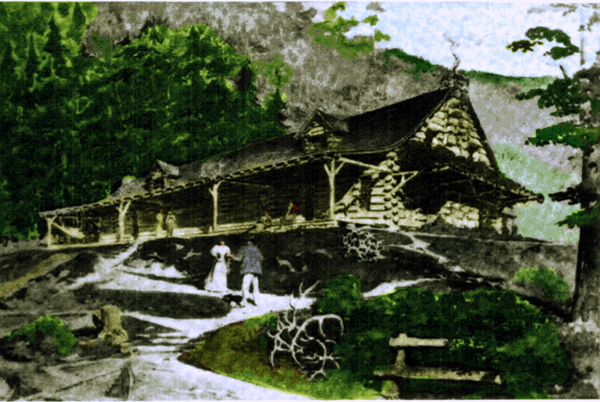
Dome Lake Club House, approx 1903.
One other archictect had a connection wwith Sheridan. Clarence Wesley Wigington, (1883-1967) an African-American,
had worked as a draftman for Kimball in Omaha. Kimball personally trained Wigington in various aspects of
archeticture. In 1908 Wigington left Kimball's employment and went out on his own.
One of his first commissions was the design of a potato chip factory in Sheridan. In order to support himself he also managed the
factory. In 1909, advertisements appeared in Sheridan newspaper advertising
"Imperial Saratoga Potato Chips" made every morning and sold in 1/2 and one pound packages. Imperial Saratoga Chips showed an
adress at 625 Custer Street. Advertisements for Wigington as an architect showed his
address at 825 North Custer. Both, however, showed the same telephone number, 589Black. [Writer's note:
at the time, there were two and three digit telephone numbers in Wheridan as well as
three digit numbers with the word "black" following the numbers. The telephone number would be given to the
operator who would then connect the caller to the desired number.]
Nothwithstanding Kimball's distinquished career and acoomplishments, the Great Depression hurt him financiallly and he
died in realative poverty from appendicitis.
Next Page, Sheridan Continued, Lower Main Street..
|